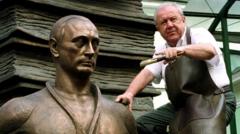In the wake of his passing, the art community reflects on Tsereteli's complex influence and enduring legacy in the world of sculpture.
Georgian-Russian artist Zurab Tsereteli, known for his larger-than-life and often polarizing sculptures, has died at the age of 91. Born in Tbilisi, Tsereteli gained prominence for his immense structures that often sparked debate, such as the gigantic 98-meter (321-foot) statue of Tsar Peter the Great in Moscow, who historically had an aversion to the city.
Tsereteli rose to fame during the Soviet era and played a prominent role as a designer for the 1980 Olympic Games in Moscow. His close ties with the Russian political elite, including his admiration for Vladimir Putin—whom he once described as possessing a "healthy soul"—often influenced his creative output. Tsereteli's friendship with former Moscow mayor Yuri Luzhkov and his standing within the Soviet elite enabled him to gain international exposure, leading to collaborations and encounters with notable figures, including Pablo Picasso.
Following his passing, Russian Foreign Ministry spokeswoman Maria Zakharova honored Tsereteli as "an artist of world renown" whose vision transcended borders, confirming, "He will live not only in our hearts but also in his works." His towering creations, however, were not without contention; many Moscow residents shared their disdain for the imposing Peter the Great monument during a heated debate over its future in 2010.
Global recognition of Tsereteli’s work includes his monumental contributions in cities worldwide, from a tribute to Christopher Columbus in Seville to a memorial for victims of the September 11 attacks in New Jersey, presented formally by the Russian government. At the United Nations Headquarters in New York, his "Good Defeats Evil" sculpture symbolizes the triumph over nuclear conflict, showcasing St. George defeating a dragon surrounded by missile fragments.
Controversy occasionally followed Tsereteli, as illustrated by the backlash against a large bronze statue he created of Pope John Paul II in a small French town, provoking debates surrounding France's secularism laws. One of his most ambitious projects, the "Birth of the New World" monument dedicated to Columbus, is among the tallest sculptures globally but faced rejection from several US cities before finding a home in Puerto Rico.
Aside from his monumental works, Tsereteli was also an accomplished painter and an architect involved in the reconstruction of Moscow's Cathedral of Christ the Saviour. With a body of work filled with intricate narratives and momentous themes, Zurab Tsereteli's artistic journey reflects a complex tapestry of admiration and contention, leaving an indelible mark on the art world.
Georgian-Russian artist Zurab Tsereteli, known for his larger-than-life and often polarizing sculptures, has died at the age of 91. Born in Tbilisi, Tsereteli gained prominence for his immense structures that often sparked debate, such as the gigantic 98-meter (321-foot) statue of Tsar Peter the Great in Moscow, who historically had an aversion to the city.
Tsereteli rose to fame during the Soviet era and played a prominent role as a designer for the 1980 Olympic Games in Moscow. His close ties with the Russian political elite, including his admiration for Vladimir Putin—whom he once described as possessing a "healthy soul"—often influenced his creative output. Tsereteli's friendship with former Moscow mayor Yuri Luzhkov and his standing within the Soviet elite enabled him to gain international exposure, leading to collaborations and encounters with notable figures, including Pablo Picasso.
Following his passing, Russian Foreign Ministry spokeswoman Maria Zakharova honored Tsereteli as "an artist of world renown" whose vision transcended borders, confirming, "He will live not only in our hearts but also in his works." His towering creations, however, were not without contention; many Moscow residents shared their disdain for the imposing Peter the Great monument during a heated debate over its future in 2010.
Global recognition of Tsereteli’s work includes his monumental contributions in cities worldwide, from a tribute to Christopher Columbus in Seville to a memorial for victims of the September 11 attacks in New Jersey, presented formally by the Russian government. At the United Nations Headquarters in New York, his "Good Defeats Evil" sculpture symbolizes the triumph over nuclear conflict, showcasing St. George defeating a dragon surrounded by missile fragments.
Controversy occasionally followed Tsereteli, as illustrated by the backlash against a large bronze statue he created of Pope John Paul II in a small French town, provoking debates surrounding France's secularism laws. One of his most ambitious projects, the "Birth of the New World" monument dedicated to Columbus, is among the tallest sculptures globally but faced rejection from several US cities before finding a home in Puerto Rico.
Aside from his monumental works, Tsereteli was also an accomplished painter and an architect involved in the reconstruction of Moscow's Cathedral of Christ the Saviour. With a body of work filled with intricate narratives and momentous themes, Zurab Tsereteli's artistic journey reflects a complex tapestry of admiration and contention, leaving an indelible mark on the art world.



















